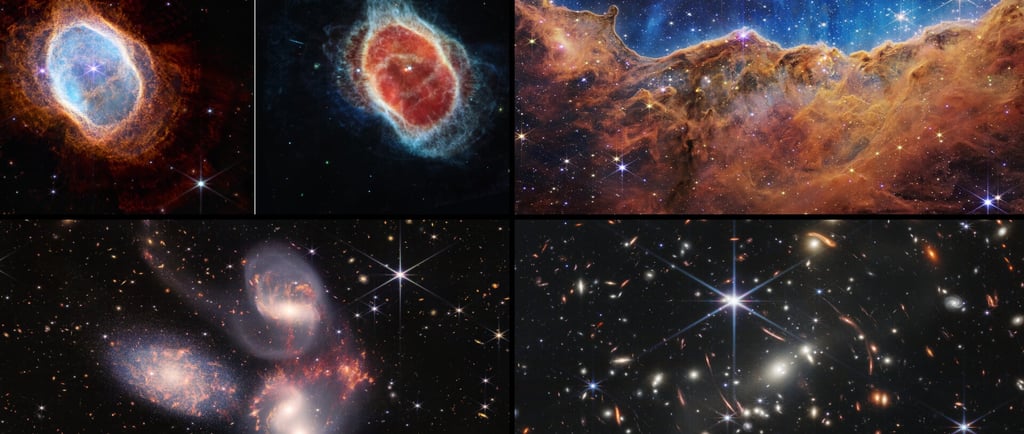Do You Know What the James Webb Space Telescope Is Revealing About the Universe
Blog post description.
TECH & SCIENCE
#DoYouKnow, #JamesWebbSpaceTelescope, #JWST, #SpaceExploration, #AstronomyFacts, #DeepSpace, #CosmicDiscovery, #Exoplanets, #StarFormation, #NASA, #ScienceForAll, #Telescope, #SpaceNews, #GalaxyHunting, #AstronomyLovers, #UniverseSecrets
7/24/20253 min read


Do you know that the James Webb Space Telescope (JWST) is offering us a deeper, clearer, and more ancient view of the universe than ever before?
Launched by NASA on December 25, 2021, JWST is the most advanced and powerful telescope humanity has ever built. It was designed to see the unseeable—from the birth of stars to the formation of planets, and the dawn of galaxies just after the Big Bang. And what it’s revealing is nothing short of extraordinary.
1. A Telescope That Looks Back in Time
The light from faraway galaxies takes billions of years to reach us. JWST can detect infrared light, allowing it to capture images of galaxies that formed over 13 billion years ago. It’s like looking into a cosmic time machine, observing the early universe as it just began to take shape.
This has already led to the discovery of galaxies that challenge our previous understanding of when and how galaxies formed.
2. Seeing Star Birth in Unimaginable Detail
Unlike its predecessor Hubble, JWST can see through clouds of dust and gas. This means it can reveal stellar nurseries, where new stars are being born. Its images of the Carina Nebula, Tarantula Nebula, and the Pillars of Creation are the most detailed cosmic photographs we’ve ever seen.
For the first time, scientists are observing how stars form and evolve in real time, with precision never imagined before.
3. Exploring Exoplanets for Signs of Life
JWST doesn’t just look at stars and galaxies. It also examines exoplanets—planets that orbit stars outside our solar system. By studying the atmospheres of these planets, JWST can detect water vapor, methane, carbon dioxide, and other gases, offering hints about the planet’s potential to support life.
It has already analyzed several super-Earths and mini-Neptunes, opening the door to a new era of planetary science.
4. Changing the Way We Understand Galaxies
Before JWST, astronomers thought early galaxies were small and chaotic. But the telescope is showing that some galaxies were already massive and structured just a few hundred million years after the Big Bang.
This has rewritten galaxy formation theories, sparking new debates in the scientific community and pushing cosmology into uncharted territory.
5. Peering into Black Holes and Quasars
Using its incredible sensitivity, JWST can observe the regions around supermassive black holes, including quasars—blazing bright cores of galaxies powered by these black holes.
This helps scientists understand how these monsters influence galaxy growth, how matter behaves in extreme gravity, and whether black holes came before or after galaxies.
6. Revealing the Universe's Chemical Composition
JWST can detect the chemical fingerprints of stars, galaxies, and nebulae. It helps scientists understand how elements like carbon, nitrogen, and oxygen—the building blocks of life—are created and spread throughout the universe.
This gives us a glimpse into how life-giving elements formed in the early universe and how they reached Earth.
7. Delivering Cosmic Art Through Images
Beyond science, JWST is also an artist. Its stunning, high-resolution images of colliding galaxies, dying stars, and nebulae are breathtaking. These images not only provide data but also inspire a sense of wonder and connection with the cosmos.
They have captured public imagination, making space science accessible and emotional for everyone.
8. Connecting Humanity to the Cosmos
JWST’s discoveries are not just for scientists. Every image, every spectrum, and every insight reminds us that we are part of a vast, shared universe. It challenges our understanding of where we come from and where we might be going.
It invites all of us—students, educators, thinkers, and dreamers—to look up and wonder.
Conclusion
The James Webb Space Telescope is a technological marvel that’s only beginning to reveal its full potential. It’s not just a telescope; it’s a time machine, a chemical lab, a planet hunter, and a cosmic storyteller.
With each passing month, JWST is rewriting textbooks, answering ancient questions, and uncovering new ones.
The universe has never felt closer—or more mysterious.
Knowledge
Empowering minds with reliable educational content daily.
Newsletter Signup
© 2025 DoYouKnow. All rights reserved.
Stay Ahead of the Trends – Join Our Newsletter
